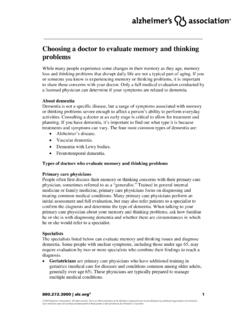Transcription of UNIT II Choosing a Design for Your Capstone Project
1 UNIT IIChoosing a Design for your Capstone ProjectCHAPTER 5 Selecting a Methodology for your Capstone Project ..61 CHAPTER 6 Designing a Clinically Based Quantitative Capstone Research Project ..71 CHAPTER 7 Designing a Clinically Based Qualitative Capstone Research Project ..86 CHAPTER 8 Designing a Clinically Based Mixed Method Capstone Research Project .. 5922/03/17 12:59 PM Jones & Bartlett Learning, LLC, an Ascend Learning Company. NOT FOR SALE OR 6022/03/17 12:59 PM Jones & Bartlett Learning, LLC, an Ascend Learning Company. NOT FOR SALE OR DISTRIBUTIONS electing a Methodology for your Capstone ProjectOBJECTIVESUpon completion of this chapter, the reader should be prepared to:1. Discuss the process involved in developing a research Project using secondary data analysis as the Discuss the process involved in developing a research Project structured as a systematic Discuss the process involved in developing a research Project using health policy development as the Discuss the process involved in developing a research Project using a gap analysis as the Discuss the process involved in developing a research Project using quality improvement as the Discuss the process involved in developing a research Project structured as curriculum Discuss the process involved in developing a research Project using a comparison of models of healthcare delivery as the methodology.
2 Secondary Data AnalysisSecondary data analysis can be a way for the nurse researcher who lacks access to additional resources or assistive personnel to make a significant analytic impact. Secondary data are essentially data collected by another individual for a purpose other than intended by the nurse researcher. Use of secondary data allows the researcher to analyze large amounts of information that may have taken years to collect, thus allowing access to data that can be rich in diversity, relatively easy to generalize to multiple populations, and dramatic in its impact. However, the nurse researcher who chooses to utilize secondary data analysis must be prepared for use of a population 61 CHAPTER 6122/03/17 12:59 PM Jones & Bartlett Learning, LLC, an Ascend Learning Company.
3 NOT FOR SALE OR DISTRIBUTION that he or she might not have selected as initial primary investigator, as well as data collection techniques that are not preferred (Blair, 2016; Smith et al., 2011).From a practical standpoint, secondary data analysis initially proceeds using the same steps that are familiar to the researcher who has been performing primary data analysis: Choosing the researchable problem, crafting a research question, selecting a study sample, and Choosing measurement and data analysis techniques appropriate for the study. Ensure that the research question used has either clinical or policy relevance so that findings are more likely to be meaningful. A significant advantage to use of secondary data analysis that utilizes publicly available data is that usually such studies progress rapidly through the institutional review board approval process (Smith et al.)
4 , 2011).An aspect of the research process that is unique to secondary data analysis is the need for the researcher to get to know his or her data set. When primary data analysis is used, the investigator selects the study population and then selects study participants from the population. In the case of secondary analysis, that familiarity with study subjects is not present and thus significant time must be devoted to determining, for example, who initially captured the data and what was the purpose of the initial data collection, if another researcher previously validated the data, and if there are obvious gaps in the data. Another issue that may arise with use of a secondary dataset is that of significance. Due to the large size of many public datasets and consequently large samples used, statistical significance can occur without corresponding clinical significance.
5 Because of this, consider Choosing a dataset that is publicly available for ease of use yet has not been frequently accessed in nursing. For example, if the research topic is the nursing workforce, consider using publicly available datasets in economics or public administration (Smith et al., 2011).Ultimately, the relatively inexperienced nurse researcher who lacks extensive time as well as resources may find secondary data analysis to be quite useful. This well-respected technique has proved to yield a rich variety of information while being simple to utilize if conducted your current workplace. If you were planning a research Project using secondary data analysis as the methodology, what documents would you utilize? Systematic ReviewsAnother excellent way to structure the DNP Project is to utilize the systematic review.
6 This technique involves a planned literature search strategy to identify, critique, and synthesize all of the relevant studies on a topic. One goal of such a technique will be to decrease the possibility of bias occurring. Systematic reviews can be especially effective when they include a meta-analysis aspect. A meta-analysis involves the use of statistical techniques to synthesize data from multiple studies into one quantitative summary effect size. Effect size is important because it measures the strength of the relationship between two 5 Selecting a Methodology for your Capstone 6222/03/17 12:59 PM Jones & Bartlett Learning, LLC, an Ascend Learning Company. NOT FOR SALE OR DISTRIBUTIONUman (2011) identified eight stages that characterize the development of a systematic review and the meta-analysis:1.
7 Develop the review question and a title for the review. Frequently researchers utilize a formulaic method of developing a title, indicating an intervention for a specific population of patients who have a particular condition. An example of this would be Focus group therapy with adolescent females experiencing bulimia. 2. Define criteria that will both include studies and exclude them from the framework of the overall systematic review. Such criteria can include the population age range, types of interventions, and minimum number of participants, for Develop a search strategy, including a list of key terms to Choose the studies to include. Initially retrieve abstracts to review, and then determine which studies appear to meet the established criteria and obtain full-text copies of them.
8 Implement the review process using at least two reviewers for interrater reliability. Maintain a log of all reviewed studies, including the reasons for including or excluding each Extract data, using a table to organize the information Assess the quality of each study utilized. Uman (2011) cites the Consolidated Standards of Reporting Trials, available at .org, as a comprehensive guideline for such a Analyze and interpret the meaning of the results. There are various statistical programs available to calculate the effect sizes for meta-analyses. Most of such programs will generate a heterogeneity value that will indicate if the studies are similar enough to compare. After analysis of the results, summarize the findings and include recommendations for additional research and patient Disseminate the findings.
9 Although systematic reviews can be quite lengthy, it is possible to publish a shortened version of a review in an academic journal. Therefore, this would be a doctor of nursing practice (DNP) Project that would have the advantage of not only fulfilling the requirements for a Project but also laying the foundation for potential publication of several journal articles (Blair, 2016; Uman, 2011).TOOLBOXYou have completed a systemic review of articles pertaining to mechanisms that oncology nurses use to manage their anxiety levels. Where would you attempt to disseminate the findings of your systematic review? List sites for publication as well as sites for possible presentation of findings. Health Policy DevelopmentThe development of a health policy in response to an identified health issue is another example of an excellent DNP Project .
10 This can result from the identification of a prob-lem with health financing, healthcare delivery, or health promotion and management. Health Policy 6322/03/17 12:59 PM Jones & Bartlett Learning, LLC, an Ascend Learning Company. NOT FOR SALE OR DISTRIBUTIONThe latter could occur in a setting that has very few stores offering nutritionally sound yet affordable food options for consumers. Johns Hopkins Bloomberg School of Public Health developed a checklist that identifies several steps in the process of health policy development:1. Clearly define the problema. How widespread is the problem?b. How prevalent is the issue?c. Who is the population primarily affected by it?d. How long has the issue been identified?e. What are the identified causes (errors of omission, missed oppor-tunities, errors of commission)?
















